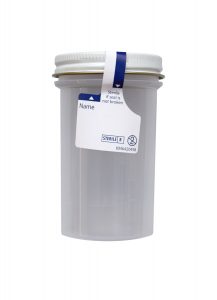Technical Brief
Detection and Typing of HSV-1 and HSV-2 in Cerebrospinal Fluid (CSF) by Polymerase Chain Reaction (PCR)
Test Name
Herpes Simplex Virus by PCR, CSF (HSPCRC)
CPT Codes
87529 (x2)
Methodology
Polymerase Chain Reaction (PCR)
Turnaround Time
1 – 3 days
Specimen Requirements
Type:
Cerebrospinal fluid (CSF)
Specimen Container:
Sterile container
Transport Temperature:
Refrigerated
Stability
Ambient:
7 days
Refrigerated:
1 month
Frozen:
Unacceptable
Additional Information
Background Information
The herpes simplex virus (HSV) is a common sexually transmitted disease virus that infects the skin, lips, oral cavity, eyes, genital tract, and central nervous system. HSV disease can range from the usual mild illness, indistinguishable in most patients, to sporadic, severe, and life-threatening disease in infants.
Infections with HSV-1 and HSV-2 can differ somewhat in their clinical manifestations and severity. HSV-1 is more frequently associated with orolabial infection (cold sores), whereas HSV-2 primarily is more frequently associated with urogenital infections in adults. Although there are differences in the frequency of infections at particular sites, in reality, both viral subtypes can cause either of these diseases.1
HSV also can cause viral central nervous system (CNS) disease. For example, HSV-1 is the most common cause of sporadic encephalitis that, if left untreated, has a high mortality rate. HSV-2 is a cause of meningitis, which occurs most frequently among young adults. Both HSV subtypes are also a cause of neonatal disease acquired during exposure of the infant to HSV-infected secretions during birth.
Early and rapid diagnosis of HSV meningitis/meningoencephalitis is important to direct therapy and minimize the suffering in affected patients. It also helps to reduce empiric antibacterial therapy and the likelihood of side effects from unnecessary therapy. In the past, diagnosis relied on brain biopsy. Fortunately, new molecular diagnostic tests, such as rapid-cycle PCR on cerebrospinal fluid, have virtually replaced the need for brain biopsy.2
Clinical Indications
Laboratory testing with PCR is routinely used as an aid in the diagnosis of HSV infections for patients with meningitis and meningoencephalitis. Despite its prevalence, HSV remains an underdiagnosed disease, and early diagnosis and detection results in improved patient care.
This test should not be used to screen patients not exhibiting signs or symptoms supportive of an HSV infection.
Limitations
Although HSV PCR represents a significant advance in the diagnosis of HSV CNS disease, a negative result does not eliminate the possibility of HSV infection.
In some patients, HSV DNA may only be present in cerebrospinal fluid for three to four weeks after the initial presentation of symptoms, and DNA levels may be undetectable over a period of time. Although false-positive results may occur, they are rare. Repeat testing should be considered for patients with a low likelihood of HSV infection if a false-positive reaction is suspected.
Methodology
A polymerase chain reaction (PCR) test on spinal fluid can detect the genetic material (DNA) of the HSV virus. This assay also differentiates the HSV-1 and HSV-2 subtypes.
Nucleic acid amplification assays, such as PCR, are the best methods for testing spinal fluid for the presence of HSV when HSV meningitis or meningoencephalitis is suspected.
The PCR test detects viral DNA in specimens and is quicker, safer, and more sensitive and specific than earlier methods. Cleveland Clinic Laboratories uses rapid-cycle PCR, which is considered the gold standard for detection of HSV in CSF specimens.
References
1. Genital Herpes: Centers for Disease Control and Prevention. Retrieved 7/18/06. Available from http://www.cdc.gov/std/healthcomm/fact_sheets.htm.
2. Herpes simplex virus infections of the central nervous system. Kimberlin DW. Semin Pediatr Infect Dis. 2003. Apr;14(2):83-9.

